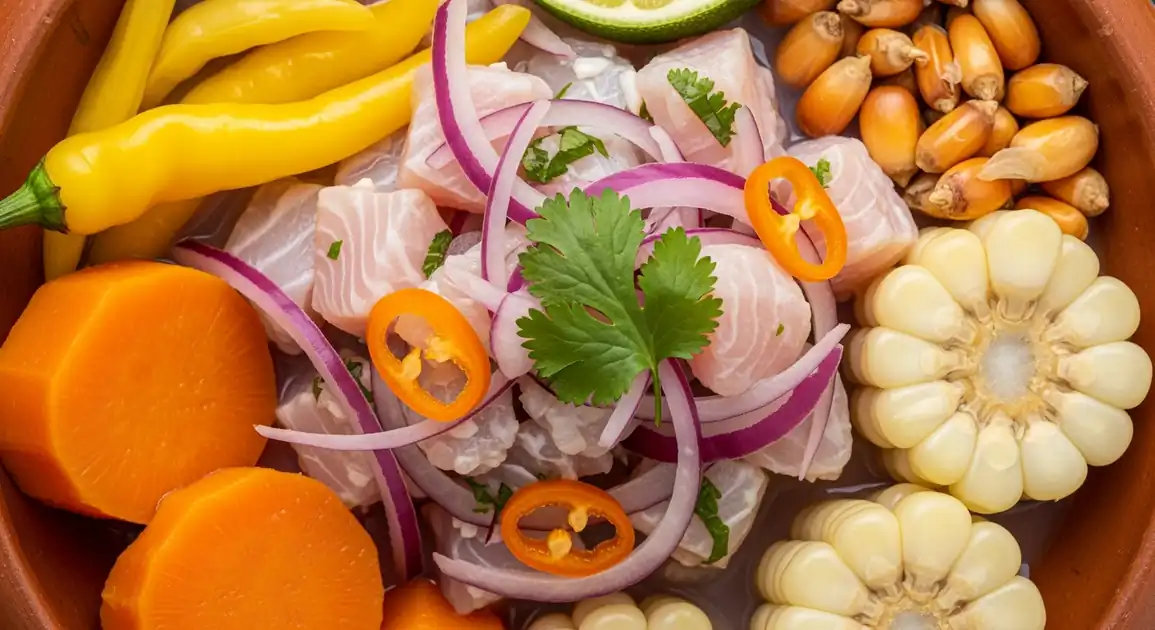Trout Ceviche
Ceviche de Trucha

Description
Cusco, the ancient Incan capital high in the Andes, has embraced Ceviche de Trucha as a signature dish that combines Peru's national preparation with locally available mountain trout. Despite being far from the coast, Cusco offers excellent ceviche options adapted to highland ingredients and Andean culinary traditions.
Dietary Information
Serving information
Serving style
In Cusco, often served in a ceramic dish with the traditional sides of sweet potato, corn, and cancha. Some upscale restaurants have incorporated Andean aesthetics into presentation, using traditional ceramics or adding local herbs as garnish.
Quick facts
Most establishments serving ceviche operate from 11 AM - 4 PM, with some tourist locations extending to dinner hours.
Safety Tips
What to Look For
-
Fish that appears translucent or slightly opaque, never dull or gray
Properly 'cooked' trout in lime juice should have a consistent, fresh appearance throughout each piece.
-
Restaurants with visible refrigeration for fish storage
Proper cold chain management is essential for raw fish safety - look for display cases or clear indicators of refrigeration.
-
Ceviche prepared to order ('al momento')
The best establishments make ceviche fresh when ordered, not in large batches sitting for hours.
-
Clean preparation areas with staff using gloves or proper utensils
Observe the kitchen (if visible) or preparation areas for cleanliness and proper food handling techniques.
-
Restaurants that can tell you when their fish was delivered
Quality establishments know their supply chain and should be able to confirm the trout is same-day or very recent.
What to avoid
-
Fishy or ammonia smell
Fresh fish should smell clean and oceanic - any strong fish odor indicates deterioration.
-
Pre-made ceviche sitting at room temperature
Ceviche should always be refrigerated until serving and made relatively recently.
-
Mushy or falling apart fish texture
This indicates either poor-quality fish or improper handling/over-marination.
-
Very cheap ceviche from street vendors without proper refrigeration
While street food is generally wonderful in Peru, raw fish requires special handling and refrigeration.
-
Cloudy, murky, or discolored marinade liquid
The leche de tigre (marinade) should be relatively clear or slightly cloudy, never murky or discolored.
Price information
Price range
Budget tips
- Local restaurants away from the main square (Plaza de Armas) often offer better value, with ceviche for 25-35 PEN.
- Some market stalls in San Pedro Market serve simpler versions for lower prices.
- Fixed-price lunch menus (menú del día) sometimes include ceviche as a starter.
- Higher prices (45-75 PEN) are common in tourist-centered restaurants.
Value indicators
- Same-day trout delivery (ask when it was received).
- Preparation visible to customers or upon request.
- Generous portion with balanced fish-to-onion ratio.
- Complex, flavorful leche de tigre that's not overly sour.
Where to Find This Dish
San Blas
Bohemian neighborhood with several authentic restaurants serving quality trout ceviche.
Plazoleta San Blas, Calle Carmen Alto
Lunch (12 PM - 3 PM)
San Pedro Market Area
Both the market itself and surrounding streets have ceviche options, from simple stalls to sit-down restaurants.
Mercado San Pedro, Surrounding streets
Morning to Early Afternoon (10 AM - 2 PM)
Plaza de Armas
Tourist-oriented restaurants around the main square serve ceviche, though often at premium prices.
Main Square, Portal de Comercio
Lunch through Afternoon
Santa Ana
Local neighborhood with less touristy restaurants often serving more authentic versions.
Plazoleta Santa Ana
Lunch (12 PM - 2 PM)
Vendor Tips
- Ask specifically about the trout source - quality restaurants can tell you which lakes or farms their fish comes from.
- Look for places where food preparation is visible or can be observed.
- Consider cevicherías that close by mid-afternoon - they're likely adhering to traditional freshness standards.
How to Order
Regional Variations
-
Altitude-Adapted Marinade
(Leche de Tigre de Altura)
Some Cusco establishments modify the traditional marinade to be slightly less acidic, as the altitude can intensify taste perceptions.
-
Andean Herb Ceviche
(Ceviche con Hierbas Andinas)
Incorporation of local herbs like huacatay (black mint), muña, or other Andean aromatics.
-
Rainbow Trout Specification
(Ceviche de Trucha Arcoíris)
Some restaurants specifically highlight the use of local rainbow trout (introduced to Lake Titicaca and other Andean lakes decades ago).
-
Cusco-Style Trout Ceviche
(Ceviche de Trucha al Estilo Cusqueño)
Features local rocoto pepper for heat and sometimes includes regional touches like native potatoes instead of standard sweet potato.
Cultural context
History
While coastal ceviche dates back centuries in Peru, the Andean trout variation emerged more recently as transportation improved and tourism developed in the highlands. Trout was introduced to Peru's Andean lakes in the 1930s and has since become an important regional ingredient. Ceviche de Trucha represents the adaptive nature of Peruvian cuisine, applying coastal techniques to highland ingredients, and has become particularly popular in tourist centers like Cusco where visitors seek out Peru's national dish while in the mountains.
Local significance
Ceviche de Trucha represents Cusco's adaptation of Peru's national dish using local ingredients. It showcases both the preservation of culinary tradition and regional innovation.
Eating customs
- In Cusco's altitude (3,400m), some find the acidity of ceviche particularly refreshing.
- Local tradition suggests squeezing additional lime if desired, but trying the chef's preparation first.
- Eating the accompanying cancha (toasted corn) throughout helps cleanse the palate.